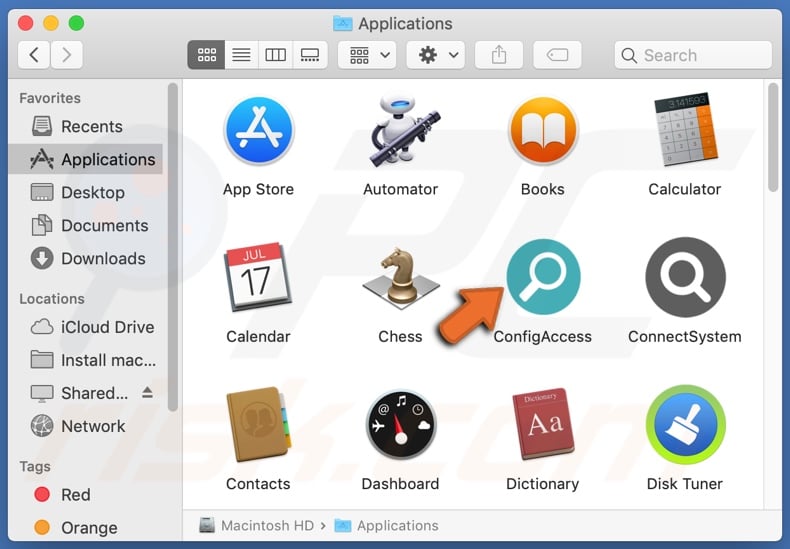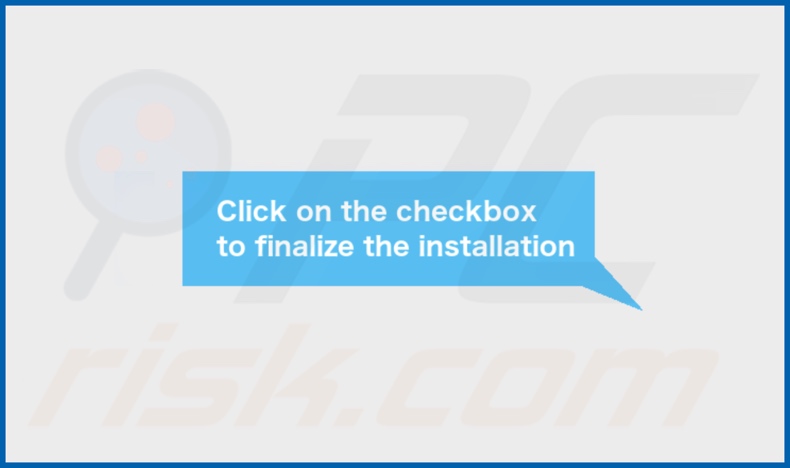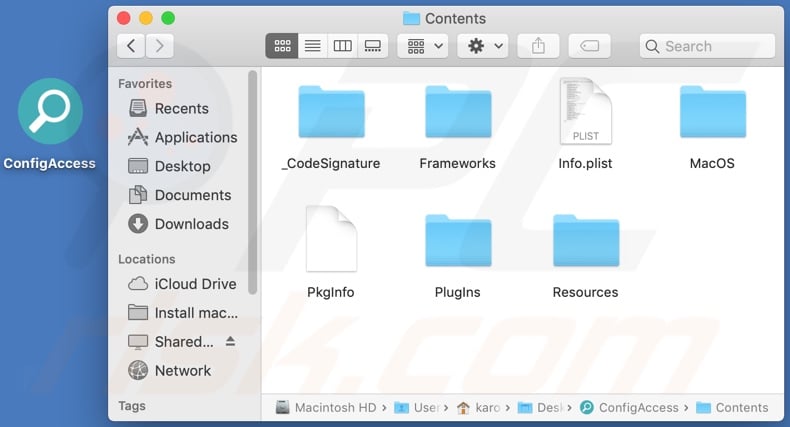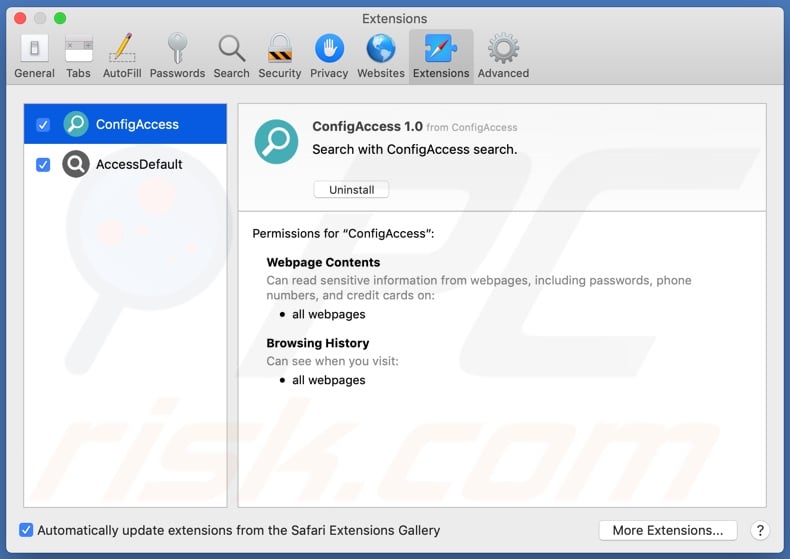How to remove ConfigAccess adware from your operating system?
Mac VirusAlso Known As: Ads by ConfigAccess
Get free scan and check if your device is infected.
Remove it nowTo use full-featured product, you have to purchase a license for Combo Cleaner. Seven days free trial available. Combo Cleaner is owned and operated by RCS LT, the parent company of PCRisk.com.
What is ConfigAccess?
ConfigAccess is a rogue application categorized as adware. It also has browser hijacker traits. This app delivers intrusive advertisement campaigns and modifies browser settings to promote fake search engines. Furthermore, such software typically has data tracking abilities.
Due to the dubious methods used to distribute adware and browser hijackers, they are also classified as PUAs (Potentially Unwanted Applications). One of the most common distribution techniques is proliferation via fake Adobe Flash Player updates.

ConfigAccess adware in detail
Adware enables the placement of third-party graphical content on any visited website and/or different interfaces. This software delivers various pop-ups, banners, coupons, surveys, full-page, and other intrusive advertisements. These ads may appear to be just a nuisance, but they severely diminish the browsing experience and endanger device/user safety.
The adverts overlay webpages and slow down the browsing speed. Intrusive advertisements endorse various sale-based, untrustworthy, deceptive/scam, and malicious sites. What is more, some of these ads can stealthily download/install software (e.g., PUAs) - once clicked on.
Browser hijackers reassign browsers' homepage, new tab/window, and default search engine URLs - to fake web searcher addresses. Hence, every new browser tab/window opened and search query typed into the URL bar - redirect to the promoted search engine.
Fake web searchers usually cannot generate search results, so they redirect to Google, Yahoo, Bing, and other legitimate ones. Browser hijackers can restrict/deny access to the browser settings, and/or reset any permitted changed made. Therefore, restoring a hijacked browser is impossible without removing the software affecting it.
Furthermore, most PUAs (adware and browser hijackers) can track data. Information of interest includes: URLs visited, webpages viewed, search queries typed, IP addresses, personally identifiable details, and so on. The collected data is then shared with and/or sold to third-parties (potentially, cyber criminals).
In summary, the presence of unwanted apps on devices can result in system infections, financial losses, severe privacy issues, and even identity theft. To protect device integrity and user privacy, all suspicious applications and browser extensions/plug-ins must be eliminated immediately upon detection.
| Name | Ads by ConfigAccess |
| Threat Type | Adware, Mac malware, Mac virus |
| Detection Names | Avast (MacOS:Adload-AG [Adw]), BitDefender (Adware.MAC.Generic.22793), ESET-NOD32 (A Variant Of OSX/Adware.Synataeb.F), Kaspersky (Not-a-virus:HEUR:AdWare.OSX.Adload.j), Full List (VirusTotal) |
| Additional Information | This application belongs to Adload malware family. |
| Symptoms | Your Mac becomes slower than normal, you see unwanted pop-up ads, you are redirected to dubious websites. |
| Distribution methods | Deceptive pop-up ads, free software installers (bundling), fake Flash Player installers, torrent file downloads. |
| Damage | Internet browser tracking (potential privacy issues), display of unwanted ads, redirects to dubious websites, loss of private information. |
| Malware Removal (Windows) |
To eliminate possible malware infections, scan your computer with legitimate antivirus software. Our security researchers recommend using Combo Cleaner. Download Combo CleanerTo use full-featured product, you have to purchase a license for Combo Cleaner. 7 days free trial available. Combo Cleaner is owned and operated by RCS LT, the parent company of PCRisk.com. |
Adware in general
ConnectSystem, AccessDefault, MapperState, and UpgradeFilter are a few examples of adware-type apps. They appear legitimate and harmless. Adware also offers a wide variety of "useful" and "advantageous" features. However, the advertised functions are seldom operational.
Practically all PUAs lure users into download/installation with features that do not work. The only aim of unwanted software is to generate profit for the developers. Therefore, instead of delivering on any promises, PUAs can run intrusive advertisement campaigns, hijack browsers, and collect private data.
How did ConfigAccess install on my computer?
PUAs are distributed through download/installation setups of other software. This deceptive marketing tactic of packing regular programs with unwanted or malicious additions - is termed "bundling". Rushed download/insulation processes (e.g., ignored terms, skipped steps and sections, etc.) increase the risk of allowing bundled content into the system.
Intrusive advertisements are used to spread PUAs as well. Upon being clicked, the adverts can execute scripts to make download/installation these applications without user consent. Some PUAs have "official" promotional webpages from which they can be downloaded and.or purchased.
How to avoid installation of potentially unwanted applications?
It is recommended to research software prior to download/installation and/or purchase. Only official and verified download channels must be used. Untrustworthy sources, e.g., unofficial and free file-hosting sites, Peer-to-Peer sharing networks, and other third-party downloaders - commonly offer deceptive and harmful content.
Download and installation processes must be approached with caution. Therefore, it is important to read terms, explore all available options, use the "Custom" or "Advanced" settings to decline downloading/installing supplementary apps, tools, functions, and other additions.
Intrusive adverts appear ordinary; however, they redirect to highly questionable websites (e.g., gambling, pornography, adult-dating, etc.). In case of encounters with ads and/or redirects of this kind, the system must be checked and all suspicious applications and browser extensions/plug-ins detected - removed from it without delay.
If your computer is already infected with ConfigAccess, we recommend running a scan with Combo Cleaner Antivirus for Windows to automatically eliminate this adware.
Pop-up window displayed once ConfigAccess adware's installation is over:

ConfigAccess adware's installation folder:

ConfigAccess adware installed onto the Safari browser:

Instant automatic malware removal:
Manual threat removal might be a lengthy and complicated process that requires advanced IT skills. Combo Cleaner is a professional automatic malware removal tool that is recommended to get rid of malware. Download it by clicking the button below:
DOWNLOAD Combo CleanerBy downloading any software listed on this website you agree to our Privacy Policy and Terms of Use. To use full-featured product, you have to purchase a license for Combo Cleaner. 7 days free trial available. Combo Cleaner is owned and operated by RCS LT, the parent company of PCRisk.com.
Quick menu:
- What is ConfigAccess?
- STEP 1. Remove ConfigAccess related files and folders from OSX.
- STEP 2. Remove ConfigAccess ads from Safari.
- STEP 3. Remove ConfigAccess adware from Google Chrome.
- STEP 4. Remove ConfigAccess ads from Mozilla Firefox.
Video showing how to remove ConfigAccess adware using Combo Cleaner:
ConfigAccess adware removal:
Remove ConfigAccess-related potentially unwanted applications from your "Applications" folder:

Click the Finder icon. In the Finder window, select "Applications". In the applications folder, look for "MPlayerX","NicePlayer", or other suspicious applications and drag them to the Trash.
After removing the potentially unwanted application(s) that cause online ads, scan your Mac for any remaining unwanted components.
DOWNLOAD remover for malware infections
Combo Cleaner checks if your computer is infected with malware. To use full-featured product, you have to purchase a license for Combo Cleaner. 7 days free trial available. Combo Cleaner is owned and operated by RCS LT, the parent company of PCRisk.com.
Remove adware-related files and folders

Click the Finder icon, from the menu bar. Choose Go, and click Go to Folder...
 Check for adware generated files in the /Library/LaunchAgents/ folder:
Check for adware generated files in the /Library/LaunchAgents/ folder:

In the Go to Folder... bar, type: /Library/LaunchAgents/

In the "LaunchAgents" folder, look for any recently-added suspicious files and move them to the Trash. Examples of files generated by adware - "installmac.AppRemoval.plist", "myppes.download.plist", "mykotlerino.ltvbit.plist", "kuklorest.update.plist", etc. Adware commonly installs several files with the exact same string.
 Check for adware generated files in the ~/Library/Application Support/ folder:
Check for adware generated files in the ~/Library/Application Support/ folder:

In the Go to Folder... bar, type: ~/Library/Application Support/

In the "Application Support" folder, look for any recently-added suspicious folders. For example, "MplayerX" or "NicePlayer", and move these folders to the Trash.
 Check for adware generated files in the ~/Library/LaunchAgents/ folder:
Check for adware generated files in the ~/Library/LaunchAgents/ folder:

In the Go to Folder... bar, type: ~/Library/LaunchAgents/

In the "LaunchAgents" folder, look for any recently-added suspicious files and move them to the Trash. Examples of files generated by adware - "installmac.AppRemoval.plist", "myppes.download.plist", "mykotlerino.ltvbit.plist", "kuklorest.update.plist", etc. Adware commonly installs several files with the exact same string.
 Check for adware generated files in the /Library/LaunchDaemons/ folder:
Check for adware generated files in the /Library/LaunchDaemons/ folder:

In the "Go to Folder..." bar, type: /Library/LaunchDaemons/

In the "LaunchDaemons" folder, look for recently-added suspicious files. For example "com.aoudad.net-preferences.plist", "com.myppes.net-preferences.plist", "com.kuklorest.net-preferences.plist", "com.avickUpd.plist", etc., and move them to the Trash.
 Scan your Mac with Combo Cleaner:
Scan your Mac with Combo Cleaner:
If you have followed all the steps correctly, your Mac should be clean of infections. To ensure your system is not infected, run a scan with Combo Cleaner Antivirus. Download it HERE. After downloading the file, double click combocleaner.dmg installer. In the opened window, drag and drop the Combo Cleaner icon on top of the Applications icon. Now open your launchpad and click on the Combo Cleaner icon. Wait until Combo Cleaner updates its virus definition database and click the "Start Combo Scan" button.

Combo Cleaner will scan your Mac for malware infections. If the antivirus scan displays "no threats found" - this means that you can continue with the removal guide; otherwise, it's recommended to remove any found infections before continuing.

After removing files and folders generated by the adware, continue to remove rogue extensions from your Internet browsers.
Remove malicious extensions from Internet browsers
 Remove malicious Safari extensions:
Remove malicious Safari extensions:

Open the Safari browser, from the menu bar, select "Safari" and click "Preferences...".

In the preferences window, select "Extensions" and look for any recently-installed suspicious extensions. When located, click the "Uninstall" button next to it/them. Note that you can safely uninstall all extensions from your Safari browser - none are crucial for regular browser operation.
- If you continue to have problems with browser redirects and unwanted advertisements - Reset Safari.
 Remove malicious extensions from Google Chrome:
Remove malicious extensions from Google Chrome:

Click the Chrome menu icon ![]() (at the top right corner of Google Chrome), select "More Tools" and click "Extensions". Locate all recently-installed suspicious extensions, select these entries and click "Remove".
(at the top right corner of Google Chrome), select "More Tools" and click "Extensions". Locate all recently-installed suspicious extensions, select these entries and click "Remove".

- If you continue to have problems with browser redirects and unwanted advertisements - Reset Google Chrome.
 Remove malicious extensions from Mozilla Firefox:
Remove malicious extensions from Mozilla Firefox:

Click the Firefox menu ![]() (at the top right corner of the main window) and select "Add-ons and themes". Click "Extensions", in the opened window locate all recently-installed suspicious extensions, click on the three dots and then click "Remove".
(at the top right corner of the main window) and select "Add-ons and themes". Click "Extensions", in the opened window locate all recently-installed suspicious extensions, click on the three dots and then click "Remove".

- If you continue to have problems with browser redirects and unwanted advertisements - Reset Mozilla Firefox.
Share:

Tomas Meskauskas
Expert security researcher, professional malware analyst
I am passionate about computer security and technology. I have an experience of over 10 years working in various companies related to computer technical issue solving and Internet security. I have been working as an author and editor for pcrisk.com since 2010. Follow me on Twitter and LinkedIn to stay informed about the latest online security threats.
PCrisk security portal is brought by a company RCS LT.
Joined forces of security researchers help educate computer users about the latest online security threats. More information about the company RCS LT.
Our malware removal guides are free. However, if you want to support us you can send us a donation.
DonatePCrisk security portal is brought by a company RCS LT.
Joined forces of security researchers help educate computer users about the latest online security threats. More information about the company RCS LT.
Our malware removal guides are free. However, if you want to support us you can send us a donation.
Donate
▼ Show Discussion